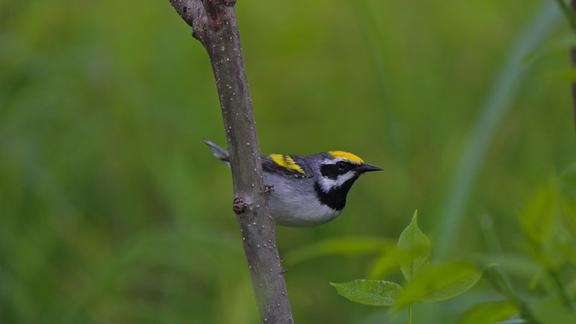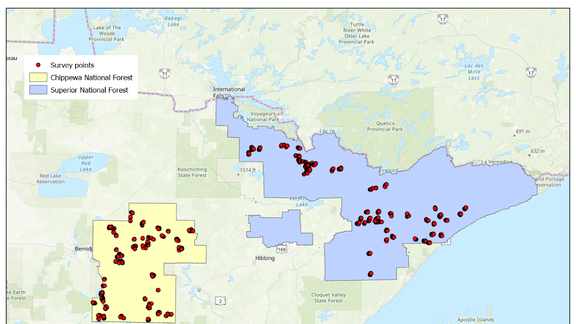Lab Overview
NRRI’s Avian Ecology Lab is an applied research program that has been studying the direct impacts of environmental change on wildlife, biodiversity, habitats, and ecosystem function for over 30 years. Using the best available technology and field techniques we gather critical data on avian and amphibian communities with a focus on species of conservation concern and vulnerable habitats. Our ecosystem-based programs focus on using birds as environmental indicators to learn about ecosystem function and implications of natural resource use and climate change. Our species-based research focuses on studying species’ ecology including assessment of diet, behavior, and habitat needs during breeding, post-breeding and migration. These data help us understand impacts of invasive species, management, restoration, and climate on ecosystem function in a rapidly changing world. Our commitment is to use this information to develop management and conservation strategies aimed at protecting biodiversity.
Lab Goals
Conduct research that contributes to knowledge of avian conservation and ecology through a combination of original research, long-term and ecological effects monitoring, education, and stakeholder engagement to develop conservation strategies to preserve and enhance species diversity.
Lab Objectives
- Develop and conduct research projects that address current and emerging threats to biodiversity.
- Use best available technology and field techniques to improve understanding of ecosystem function, habitat, and species-specific needs to inform conservation and management.
- Disseminate information, expertise, and guidance to stakeholders to support resource management decisions to preserve and enhance wildlife diversity.
Avian Ecology Research
Our ecosystem-based projects focus on using birds as environmental indicators to learn about ecosystem function and implications of change in land use and climate change. Our species-based research focuses on studying species’ ecology including assessment of diet, behavior, and habitat needs during breeding, post-breeding and migration to inform management and conservation efforts.
Current Research
- Long-term monitoring of bird populations
- Minnesota National Forest Bird Monitoring Program
- Coastal Wetland Anuran and Avian Monitoring
- Forested peatland ecosystems
- Focal species:
- Boreal Chickadee
- Connecticut Warbler
- Focal species:
- Managed landscapes
- Focal species:
- Golden-winged Warbler
- American Woodcock
- Veery
- Nashville Warbler
- Least Flycatcher
- Canada Warbler
- Ruffed Grouse
- Sharp-tailed Grouse
- Focal species:
- Forested wetlands
- Focal species:
- Rusty Blackbird
- Winter Wren
- Focal species:
- Coastal wetland ecosystems
- Prairie ecosystems
- Aerial insectivores
- Focal species:
- Common Nighthawk
- Eastern Bluebird
- Tree Swallow
- Focal species:
- Colonial waterbirds
- Focal species:
- Common Tern
- Black Tern
- Forster’s Tern
- Focal species:
Tools and techniques we use to study birds
- Autonomous recording units: We deploy these audio recording devices in a variety of habitats to complement point count surveys.
- Camera traps: We use camera traps to collect data for several projects including assessment of songbird predation and stopover use of migrating shorebirds.
- Drones: Drones are used in our research for monitoring and habitat assessments.
- eDNA: We use DNA metabarcoding and next- generation sequencing techniques to understand the diet of focal species.
- Habitat assessments: We conduct in-depth vegetation surveys to quantify habitat characteristics that are important for focal species.
- Insects: We conduct insect surveys to understand food availability and abundance for focal species during the breeding season.
- Isotopes: We use isotopes to study ecosystem processes including diet assessment and impacts of contamination for focal species.
- Point count and line transect surveys: Field crew undergo rigorous training to be able to identify over 100 species by sight and song. Over 1,000 point counts are conducted annually by our team of experts!
- Small mammal surveys: We conduct small mammal surveys to determine the presence and abundance of small mammals in focal habitats and ecosystems.
- Tracking: We use a variety of tracking technologies including geolocators, GSM and GPS tags, RFID, Motus and hand-held telemetry to study movement ecology of focal species.
Research Projects
Current research projects include:
- Minnesota National Forest Breeding Bird Monitoring Program
- Managing Minnesota's Forest Birds of Conservation Concern
- Maximizing Wildlife, Water, & Productivity in Peatland Forests
- Common Tern Conservation in the Great Lakes
- Great Lakes Coastal Wetland Monitoring Program (CWMP)
- Visible Migration of Common Nighthawks
- Boreal Chickadee Breeding Ecology
- Connecticut Warbler Breeding Ecology
- Golden-winged Warbler Breeding Ecology
- Improving Golden-Winged Warbler Conservation and Habitat Restoration
- What’s “Bugging” Minnesota’s Insect-Eating Birds?
- Conserving Black Terns and Forster's Terns in Minnesota
- EAB: Maintaining Forests and Benefits
- Assessing Status of Common Tern Populations in Minnesota
- Sharp-tailed Grouse in Barnes Barrens Management Area
Our Partners
Work with us!
Partners and Collaborators
- Aitkin County
- American Bird Conservancy
- Bad River Tribe
- Bayfield County
- Black Tern Working Group
- Cass County
- Chippewa National Forest
- City of Duluth
- City of Superior
- Environment and Climate Change Canada
- Environmental Protection Agency
- Fond du Lac Band of Lake Superior Chippewa
- Forest Stewardship Guild
- Forestry for Minnesota Birds
- Golden-winged Warbler Working Group
- Great Lakes Audubon
- Hawk Ridge Bird Observatory
- Leech Lake Band of Ojibwe
- Midwest Migration Network
- Mille Lacs Band of Ojibwe
- Minnesota Audubon
- Minnesota Department of Natural Resources
- Minnesota Land Trust
- Minnesota Pollution Control Agency
- Minnesota Power
- National Estuarine Research Reserve
- Northern Forest Bird Network
- Private landowners
- Ruffed Grouse and American Woodcock Society
- Rusty Blackbird Working Group
- Superior National Forest
- The Nature Conservancy
- Two Harbors High School
- University of Minnesota College of Food, Agricultural, and Natural Resource Sciences
- University of Minnesota, Conservation Sciences
- UPM Blandin
- USDA Forest Service- Northern Research Station
- USDA Forest Service- Pacific Northwest Research Station
- Wisconsin Department of Natural Resources
- Wolf Ridge Environmental Learning Center
Research Projects

A study of habitat and survival rates of species in decline to inform forest management practices.
Use a combination of wildlife, vegetation, and hydrology (water) measurements to determine the impacts of logging on peatland forests.

The Minnesota Breeding Bird Atlas documents the distribution of every breeding bird species in Minnesota and provides a solid foundation for future conservation efforts.

Documenting long-term population trends of breeding forest birds in the Chippewa and Superior National Forests.
Media Coverage
- – Detailed accounts of 250 birds in Minnesota – Hometown Focus
- – Talking Minnesota’s migratory birds with U of M – University of Minnesota News
- – Birds and climate: it’s a complex relationship – Hometown Focus
- – Birds, bugs and climate change – MPR News
- – Connecticut Warbler and other songbird populations on the decline in Superior National Forest – WTIP
- – Talking Minnesota’s migratory birds with U of M – University of Minnesota Talking with U of M
- – Potential impacts of emerald ash borer on wildlife in black ash wetlands – University of Minnesota Research Brief
- – Study reveals woodcock wintering grounds – Duluth News Tribune
- – For 2 weeks every August, Duluth is the nighthawk capital of the world – Minnesota Public Radio
- – Green Visions: "This is a warning signal from our world" – KUMD
- – Duluth is nighthawk capital of world 2 weeks each year – Duluth News Tribune
- – Fens, bogs and peatlands: 6+ million acres of Minnesota’s unsung wilderness treasure – Quetico Superior Wilderness News
- – Boreal Birding in the Bogs of Northern Minnesota – Quetico Superior Wilderness News
- – He counts the birds by the thousands – Star Tribune
- – Hunting for answers on forest bird decline – Duluth News Tribune
- – Scientists hang 500 birdhouses in Sax-Zim Bog to study boreal chickadees – Duluth News Tribune
- – Terns face challenges when they fly south for winter – Science Daily